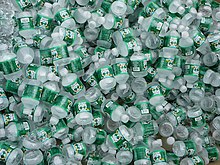



This is a list of bottled water brands. Bottled water is drinking water (e.g., well water, distilled water, mineral water, or spring water) packaged in plastic, cartons, aluminum, or glass water bottles. Bottled water may be carbonated or not. Sizes range from small single serving bottles to large carboys for water coolers. The environmental impact of bottled water is 3,500 times that of tap-water.[1]
Bottled water brands[edit]
- Absolute[disambiguation needed]
- Acqua Panna
- Adelholzener Alpenquellen
- AdeS– sold only in Indonesia[2]
- Agua Mineral Salus
- Agua Vida
- Ambo Mineral Water[3]
- Amma Kudineer
- Antipodes Water Company
- Apenta
- Apollinaris
- Aqua Pura
- Aquafina
- Arrowhead Water
- Arwa
- Badoit
- Bai Brands
- Ballygowan
- Bear-lithia
- Belu
- Bílinská kyselka
- Bisleri
- Bonafont
- Borjomi
- Buxton (UK)
- Ciego Montero
- Ciel
- Contrex
- Cool Ridge
- CORE
- Crystal Clear
- Crystal Geyser Water Company
- Culligan
- Damavand Mineral Water
- Dana
- Danone
- Dasani
- Deep River Rock
- Deep Spring
- Deer Park Spring Water
- Dejà Blue
- Donat Mg
- Ein Gedi Mineral Water
- Energy Brands
- E-Pura
- Ethos Water
- Evian[4]
- Farris
- Fiji Water[5]
- Fjord
- Fruit2O[6][7]
- Fuentealta
- Ganten
- Gerolsteiner Brunnen
- Glaceau
- Gourmet Foods
- Harrogate Spa Water
- Highland Spring
- Himalayan
- Hiram Codd
- Ice Mountain
- Iceland Pure Spring Water
- Icelandic Glacial
- Isklar
- Jamnica
- Jana
- Jermuk
- Kellogg's Special K2O Protein Water
- Knjaz Miloš a.d.
- Liquid Death
- Lithia
- Londonderry Lithia
- Mai Dubai
- Malvern Water
- Mattoni
- Mey Eden
- Istisu
- Badamli
- Sirab
- Mohai Agnes mineral water
- Mount Franklin Water
- Mountain Valley Spring Water
- Nabeglavi
- Nature’s Spring
- Naya Waters
- Nestlé Pure Life
- Nestlé Waters North America
- Nestlé Waters
- Neviot
- NEWater
- Nongfu Spring
- Ozarka
- Panama Blue
- Pennine Spring
- Penta Water[7]
- Perrier
- Pluto Water
- Poland Spring
- Polar
- Powwow Water
- Princes Gate Spring Water
- Propel Fitness Water[7]
- Radenska
- Ramlösa
- San Pellegrino
- Sairme
- San Mateo
- Sanfaustino
- Selters
- Sierra Springs
- Sohat
- Souroti
- Spa
- Sparkletts
- Staatl. Fachingen
- Summit
- Tannourine
- Tau
- Tipperary Natural Mineral Water
- Topo Chico
- Trump Ice
- Tŷ Nant
- Valpre
- VEEN
- Verna Natural Mineral Water, sold in Ghana, Burkina Faso and Togo
- Vittel
- Vita Coco
- Volvic
- Vöslauer
- Voss
- Watsons Water
- Whistler Water
- Wet[disambiguation needed]
- Wilkins[disambiguation needed]
- Zaječická hořká
- Zephyrhills
- Żywiec Zdrój
References[edit]
- ^ "Environmental impact of bottled water '3,500' times greater than tap water". Independent.co.uk. 5 August 2021.
- ^ "Coke Brands Around The World". Forbes. Retrieved 3 June 2015.
- ^ Wonacott, Peter (January 13, 2011). "SABMiller Taps Ethiopia's 'Holy Water'". The Wall Street Journal. Retrieved June 3, 2015.
- ^ Segal, David (January 25, 2005). "Bottled Buzz". Washington Post. Retrieved June 3, 2015.
- ^ "Hollywood couple buys Fiji Water for $63m - Business". The Sydney Morning Herald. November 29, 2004. Retrieved June 3, 2015.
- ^ Shimp, T. (2008). Advertising Promotion and Other Aspects of Integrated Marketing Communications. Deca Series. Cengage Learning. pp. 62–64. ISBN 978-0-324-59360-0.
- ^ a b c "A Look At Bottled Water". CBS News. July 15, 2002. Retrieved June 3, 2015.
Well, that’s interesting to know that Psilotum nudum are known as whisk ferns. Psilotum nudum is the commoner species of the two. While the P. flaccidum is a rare species and is found in the tropical islands. Both the species are usually epiphytic in habit and grow upon tree ferns. These species may also be terrestrial and grow in humus or in the crevices of the rocks.
View the detailed Guide of Psilotum nudum: Detailed Study Of Psilotum Nudum (Whisk Fern), Classification, Anatomy, Reproduction